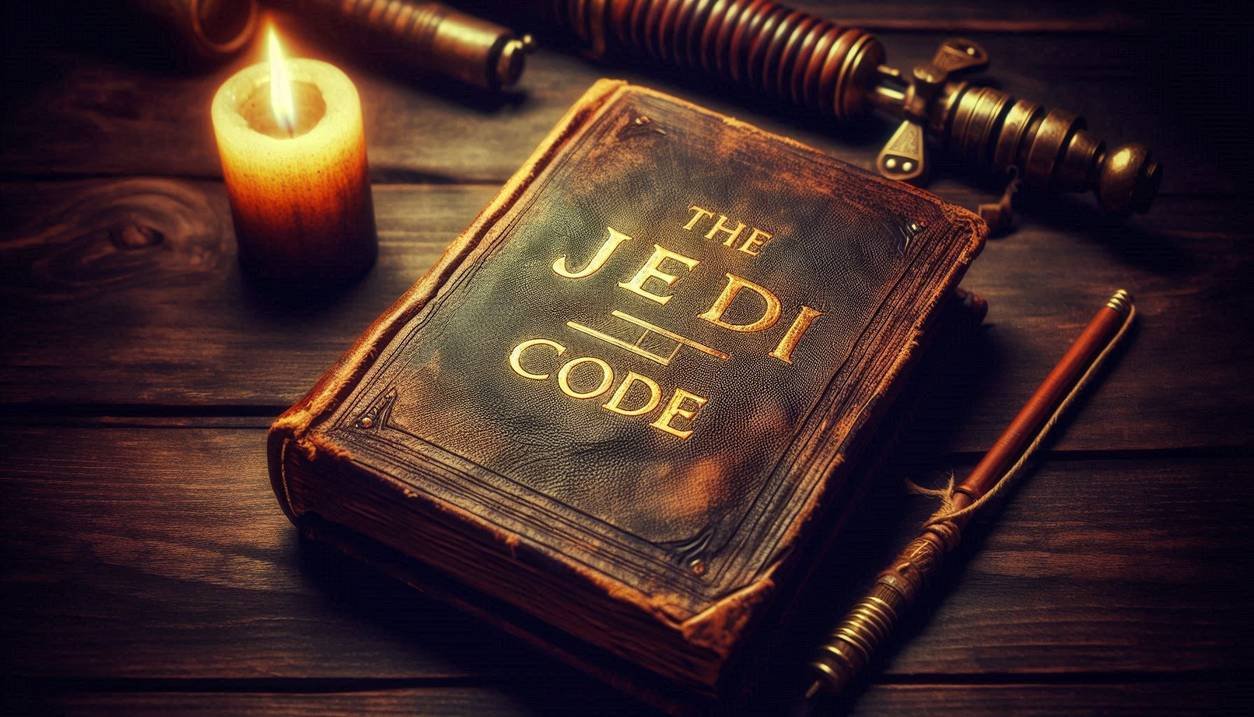1. What is the Jedi Code?
The Jedi Code was a collection of principles and doctrines that guided the actions of the Jedi Order. This code evolved over centuries and was applicable to all Jedi ranks within the Order, including Initiates, Padawans, Knights, and Masters.
One of the guidelines within the Code prohibited any Jedi from training more than one Padawan at any single time. Additionally, the Code represented the Order’s core philosophical values, emphasizing self-discipline, introspection, and restraint, and was designed to help Jedi stay committed to the light side of the Force by avoiding the allure of the dark side.
In the Imperial Era, only a few followers of the Jedi Code remained after the Great Jedi Purge, which nearly eliminated the Order. When the Order was reestablished during the New Republic Era, Jedi Master Luke Skywalker trained his apprentices, including his nephew Ben Solo, to uphold the principles of the Jedi Code.
2. Origins and Evolution of the Jedi Code
The Jedi Code developed over centuries, driven by the Order’s commitment to stay aligned with the light side of the Force by rejecting any path that led to the dark side. The so-called “Prime Jedi,” the founder and first member of the Jedi Order, followed an early version of the Jedi Code as the first to wield the Force, thereby becoming the earliest figure to use the Force under an initial Jedi Code.

The modern version of the Code was believed to have been created by Jedi Master Odan-Urr. Marda Ro, a member of the Path of the Open Hand who had fallen in love with the Padawan Kevmo Zink, believed she could persuade him to abandon the ways of the Jedi so he could join her in the Path. However, Zink was ultimately killed by the Great Leveler, and Ro blamed the Jedi, claiming they had indoctrinated him with misguided beliefs.
Although the Code was mandatory for all Jedi, Jedi Master Qui-Gon Jinn was known for prioritizing the will of the Force over the tenets of the Code. His tendency to defy the Jedi High Council placed him at odds with the Order’s leadership and even his apprentice, Obi-Wan Kenobi, who felt that Jinn might have joined the Council if he had strictly followed the Code.
In the last years of the Galactic Republic, Jinn offered to train Anakin Skywalker, who was believed to be the Chosen One, but the High Council rejected his offer due to the Code’s restriction against training multiple Padawans. However, following the Invasion of Naboo, the Council permitted Kenobi to train Skywalker after Jinn’s death at the hands of the Sith apprentice Darth Maul.
Iskat Akaris, a Jedi Knight who rose to her position during the Clone Wars, found it challenging to follow the Jedi Code, particularly the line “there is no death, there is the Force.” Observing other Jedi, she felt the Code’s words were hollow. Once, when she was tasked with teaching the Code to younglings, she unconsciously recited parts of it backward, saying, “There is no serenity, there is passion.” Although she claimed this was a test to see if the younglings would notice, it actually reflected her inner conflict.
During the Clone Wars, Republic officer Captain Wilhuff Tarkin believed the Jedi Code prevented the Order from doing what was necessary to secure victory against the Confederacy of Independent Systems. Although Jedi General Obi-Wan Kenobi regarded Tarkin’s views as overly simplistic, Tarkin argued that the Jedi should relinquish their command over the Grand Army of the Republic, a stance that Jedi Commander Ahsoka Tano opposed.
Shortly before the end of the Clone Wars, Anakin Skywalker was asked by Kenobi and other members of the Jedi High Council to spy on Supreme Chancellor Sheev Palpatine, which Skywalker believed violated the Jedi Code.
As part of his mission to revive the Order, Luke Skywalker trained his apprentices in the ways of the Jedi. Due to his unconventional training, he wanted to provide his students with a more traditional Jedi experience. As a Jedi, Skywalker followed the principles of the Jedi Code and expected his disciples, including his nephew Ben Solo, to show the same dedication.
Skywalker devoted his life to the Jedi path, refraining from romantic relationships, distancing himself from former friends, and working tirelessly to rebuild the Order. Although his commitment to the Jedi Code gave him a sense of fulfillment, Skywalker felt a measure of guilt for the time he spent away from his friends, despite the Code’s teachings on maintaining personal detachment.
In 34 ABY, Rey heard the soft chanting of the Jedi Code coming from the tree library that housed the original Jedi texts on Ahch-To. Drawn by the chanting, she entered the library, discovering the texts and beginning to learn more about the Jedi Order’s history from Luke Skywalker.
3. What Are the Core Tenets of the Jedi Code?
The Jedi Code was a set of principles and rules that shaped the actions and beliefs of the Jedi Order. The Code encouraged its members to resist feelings of anger toward other living beings, which helped them avoid fear and resist the dark side of the Force.

The Jedi Code restricted each Jedi to training only one apprentice at a time. The Code also prohibited Jedi from killing defenseless opponents as well as from pursuing revenge. Among its other guidelines, the Jedi Code prevented Jedi Knights and Jedi Masters from instructing more than one Padawan at any point in time.
Attachment was also forbidden by the Code. Grand Master Yoda warned that attachment fostered jealousy, greed, and eventually the fear of loss, all of which could lead to the dark side. Ahsoka Tano similarly viewed attachment as dangerous and declined to train Grogu as an apprentice due to the youngling’s connection with the Mandalorian bounty hunter Din Djarin.
Despite the restrictions on attachment, the Code promoted compassion as a central element of the Jedi lifestyle, teaching that all lives were valuable, though outsiders often misunderstood this. Although Jedi did not marry, the Code did not forbid romantic feelings or familial love. However, succumbing to personal attachment was viewed as abandoning the Jedi path, whose teachings rarely aligned with typical family bonds.
4. What Does the Jedi Code’s Mantra Teach?
A Jedi like Obi-Wan Kenobi, trained in the principles of the light side of the Force, could draw peace from the teachings of the Jedi Code’s mantra:
“There is no emotion, there is peace.
There is no ignorance, there is knowledge.
There is no passion, there is serenity.
There is no chaos, there is harmony.
There is no death, there is the Force.”
There was also a different version of the Code, recited by Jedi younglings during their Initiate Trials and by Depa Billaba when she retook her full fitness assessment after a six-month coma:
“Emotion, yet peace.
Ignorance, yet knowledge.
Passion, yet serenity.
Chaos, yet harmony.
Death, yet the Force.”
An additional, older form of the Code, known by the year 382 BBY, emphasized that Jedi sought knowledge and enlightenment over selfish desires for personal power or gain. Jedi Master Vildar Mac and Jedi Knight Oliviah Zeveron knew this older mantra by heart, while Padawan Matthea Cathley was familiar with it only from historical records. Despite its age, the tenets within the older mantra remained true to Jedi conduct. This version included:
“A Jedi does not act for personal power or wealth
But only seeks knowledge and enlightenment.”
5. How Did the Jedi Code Influence Jedi Actions?
The Jedi Code influenced Jedi actions by guarding against the dark side, addressing love and attachment, balancing relationships with responsibilities, managing emotions to maintain serenity, and shaping their perspective on death.
5.1 How Did the Jedi Code Guard Against the Dark Side?
Jedi were trained to accept the dark side within themselves and to master it rather than allowing it to control them. Fear of loss, anger, hatred, jealousy, greed, and aggression—elements of the dark side—had to be stripped of their influence over a Jedi through patience and training.
5.2 How Did the Jedi Code Address Love and Attachment?
While the Jedi Code forbade possession and attachment, the Jedi were encouraged and trained to love in terms of compassion. Jedi Master Zallah Macri, when explaining the Code to her apprentice Kevmo Zink, explained that a Jedi was “allowed to like people and things” but that attachments could not dominate their lives. Jedi Knight Indeera Stokes said that love and the experience of joy, affection, and grief were part of the light side; however, a Jedi could not be controlled by these emotions.
Attachment was the refusal to accept that change was a part of life, the inability to accept death as natural, or the reluctance to let go. This attitude fueled the fear of loss and greed, which could lead to jealousy, a selfish state that inclined one toward the dark side. Therefore, attachment was prohibited for Jedi, who trained to let go of everything they feared losing.

In this way, Jedi could show compassion, love, and care without becoming possessive or clinging to things, instead accepting the ever-changing nature of life. This allowed them to love all life without becoming attached to specific individuals.
An example of a Jedi whose attachments led to the dark side was Anakin Skywalker, who turned to the Sith in his obsessive desire to gain the power to save his wife from death.
5.3 How Did the Jedi Balance Relationships with Their Responsibilities?
Jedi saw one another as family, and sometimes they even had true blood relations. Jedi Masters developed deep bonds with their apprentices, raising them with the love and trust of a parental figure. However, they were expected to avoid attachments, ready to release their apprentices if necessary for the greater good, prioritizing the lives of many over the life of one.
The Jedi viewed romantic feelings as “natural,” not explicitly forbidden. Jedi Master Obi-Wan Kenobi noted, though, that Jedi weren’t meant to engage in romantic relationships. A Jedi Knight had to make the right choice for the Order and avoid neglecting their Jedi responsibilities for a personal relationship, even if it meant ending that relationship.
Jedi Knight Rael Averross believed the Code allowed for casual relationships as long as they did not involve attachments. Averross had such a relationship with Selbie, an innkeeper on Pijal, while he served as Lord Regent there. His friend and fellow Jedi, Qui-Gon Jinn, disagreed with Averross’s interpretation of the Code.
5.4 How Did Jedi Manage Emotions to Maintain Serenity?
The Jedi were encouraged to rely on their instincts over intellectual analysis. They valued their emotions but were taught to be aware of them, as unchecked emotions could cloud their judgment. Maintaining a calm, clear mind was essential for a Jedi to stay aligned with the light side of the Force and avoid the dark side. In this balanced state, they could keep the Force within them stable.
5.5 What Was the Jedi Perspective on Death?
The Jedi recognized that the universe was dynamic and that all life forms eventually passed on. They held a strong belief in the Force, finding comfort in knowing that, upon death, they, like all living things, would merge with the Cosmic Force, which was the origin of the Living Force. This understanding allowed them to view death as a natural part of existence.
Although death brought sadness, they were reminded to accept their eventual passing and to celebrate the lives of those who became one with the Force rather than grieving their loss. The fear of losing others to death stemmed from attachment, a shadow of greed.
6. What Are the Limitations and Criticisms of the Jedi Code?
Despite its noble intentions, the Jedi Code has been criticized for its rigid approach, particularly in the areas of emotional suppression and restrictions on attachment. The Code’s insistence on emotional restraint often leads to repression rather than true mastery, which has proven problematic for several Jedi, including Anakin Skywalker, who struggled to reconcile his love and fear for those he cared about. This aversion to attachment made it challenging for Jedi to form healthy personal relationships, isolating them in moments when they may have needed support most.
The rigidity of the Jedi Code has even been linked to the Order’s eventual downfall. By strictly adhering to a set of unbending rules, the Jedi may have failed to adapt to the changing galaxy and the evolving threat posed by the Sith. This lack of flexibility, along with an unwillingness to accept alternative viewpoints, left them vulnerable, unable to foresee the rise of Emperor Palpatine and the eventual collapse of the Republic.
Explore Our Lightsaber Collection
Tony Allen is a writer for LightsabersBlog.com, a website focused on everything related to lightsabers. Tony grew up in Austin, Texas, and went on to study Mechanical Engineering at the University of Texas. Passionate about science fiction and fantasy, Tony has always been deeply involved in hobbies like tabletop RPGs, sci-fi novels, miniature painting, and crafting. This love for creative pursuits drives Tony to write about lightsabers in a way that ignites the imagination of fans around the world.









































